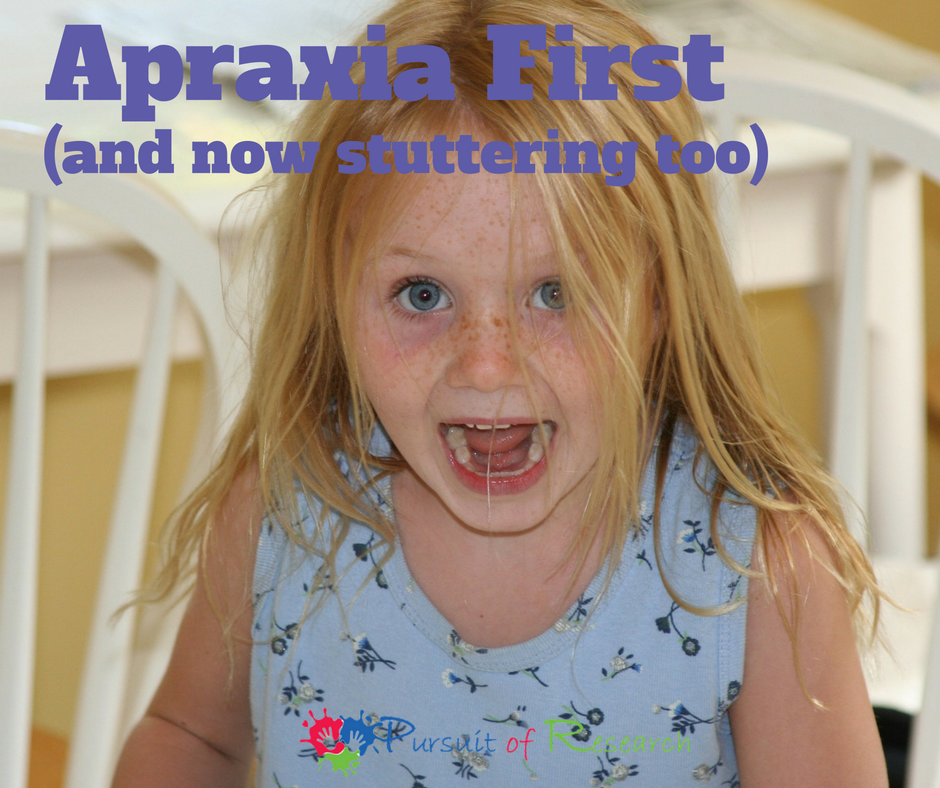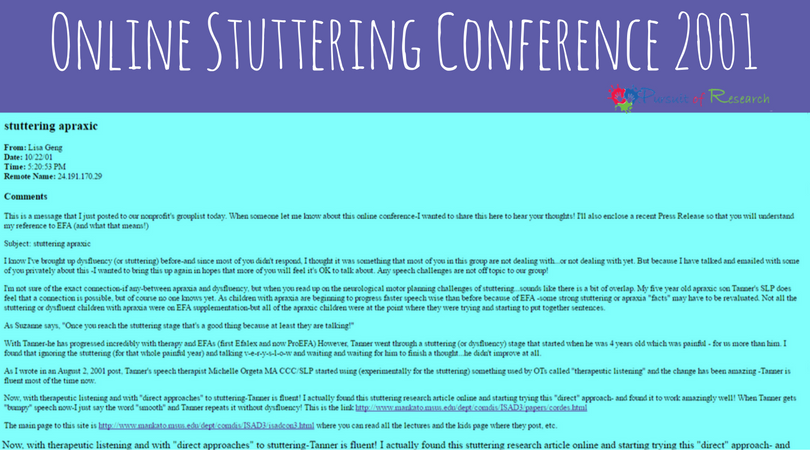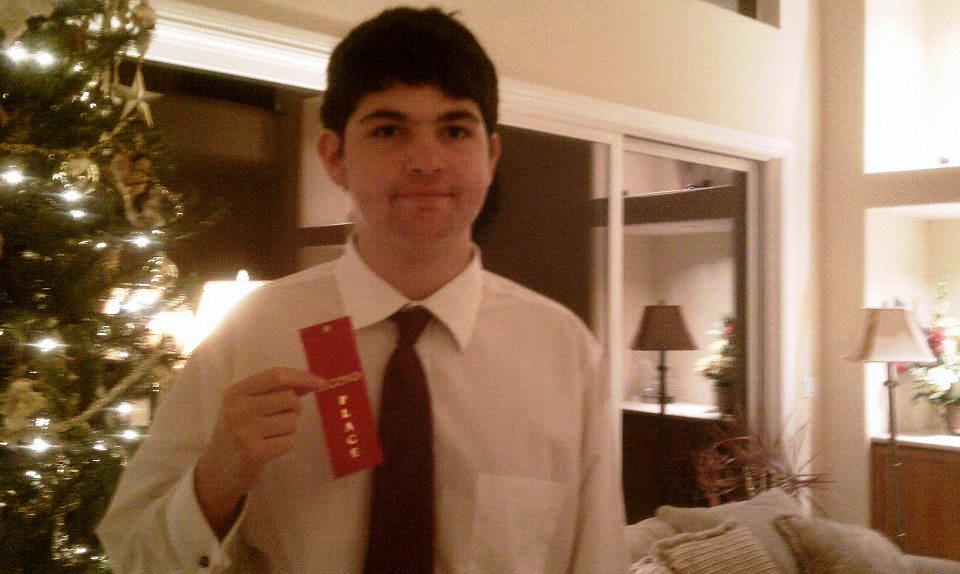If your child has apraxia, sometime after speech starts to comes in, perhaps around the age of 4 to 6 years old, there are a percentage that go through a developmental stuttering stage. This is a stage that can happen in neurotypical children and it’s not the same thing as true stuttering.

My son Tanner was a child with apraxia that went through a developmental stuttering phase, and it’s extremely frustrating for both your child as well as for the entire family. I did take Tanner to 2 PhDs SLP who specialize in stuttering that I found through the Stuttering Foundation (one in NJ and one in Florida) and didn’t tell either about what the other said -but both told me that it was developmental stuttering and to cut out any articulation therapy and just focus on slow and easy speech. I was also told to not let any SLPs use any stuttering therapy on my son as he had developmental stuttering. This is a stage that can happen in neurotypical children and it’s not the same thing as true stuttering.
Kids with Apraxia Tend To Get Stuck In the Stuttering Phase
If your child does go through a stuttering phase, it may come and go over a period of months, or even years. My son Tanner’s stuttering phase went on for so long we nicknamed it Mr. Bumpy. We all hated Mr. Bumpy when he came around! One of the SLPs I brought Tanner to was Dr. Dale Williams CCC SLP. At the time which was quite a few years ago now, in addition to letting me know that Tanner’ s dysfluency stage was not classic stuttering but developmental stuttering, he said to me, “You are correct that we have done an injustice in not studying apraxia in children enough yet. For this reason we don’t know what is ‘normal’ for an apraxic child as to how long they will stay in the developmental stage of dysfluency, but we are finding it can be quite long”
If your child has apraxia and has started to stutter, find out from your child’s SLP if they are doing articulation therapy, because the advice I heard from experts in this area is all articulation therapy has to stop till this phase passes. The SLP can focus on motor planning therapies, sensory therapies, oral motor therapies, strenghthening therapies, just not articulation therapy.
Slow and Easy Speech
When your child starts to talk do the following:
- Relax your body and take a deep breath and hold it, gradually letting it out while your child is speaking
- Listen patiently to what they are saying. Even if you know what they are trying to say don’t say it for them.
- If you can get down on your child’s level and remain calm.
- Even if you are busy, if at all possible act like you have all the time in the world.
- When they are done saying what they want to say, repeat it back to them with slow and easy speech.
In 2001 when my son Tanner was around 5 years old, the photo below is one of the comments I wrote for an online stuttering conference hosted by Minnesota State University Mankato.

A clip of what I wrote “I’m not sure of the exact connection-if any-between apraxia and dysfluency, but when you read up on the neurological motor planning challenges of stuttering…sounds like there is a bit of overlap. My five year old apraxic son Tanner’s SLP does feel that a connection is possible, but of course no one knows yet. As children with apraxia are beginning to progress faster speech wise than before because of EFA -some strong stuttering or apraxia “facts” may have to be revaluated. Not all the stuttering or dysfluent children with apraxia were on EFA supplementation-but all of the apraxic children were at the point where they were trying and starting to put together sentences.
As Suzanne says, “Once you reach the stuttering stage that’s a good thing because at least they are talking!”
With Tanner-he has progressed incredibly with therapy and EFAs (first Efalex and now ProEFA) However, Tanner went through a stuttering (or dysfluency) stage that started when he was 4 years old which was painful – for us more than him. I found that ignoring the stuttering (for that whole painful year) and talking v-e-r-y-s-l-o-w and waiting and waiting for him to finish a thought…he didn’t improve at all.
I found this stuttering research article online and starting trying this “direct” approach
Stuttering Apraxic, What Do The Experts Say?
One of the other parents who joined this online conference was Rhonda, the founder of the nonprofit Echo from Canada which used to exist. Rhonda’s child also had apraxia and was going through a developmental stuttering phase as well and she spoke to some of the researchers who told her that in theory apraxia, which is a motor planning impairment, could be the most severe form of stuttering as stuttering is also a motor planning impairment.
From The Neuroscience on the Web Series: CMSD 642 Neuropathologies of Swallowing and Speech CSU, Chico, Patrick McCaffrey, Ph. D Chapter 8 Apraxia: Definition and Description: Site of Lesion
- There is greatest difficulty in initiating speech, as noted by hesitations, and nonfluencies, visible searching, groping movements of the articulators, numerous trials, and false starts (this resembles stuttering).
- Like stutterers, apraxics will sometimes realize that they are going to have difficulty producing an up-coming sound and hesitate. Such pauses make apraxic speech dysfluent and impairs prosody.
- Initial consonants are misarticulated more frequently than are consonants in other positions. -This is another way in which apraxic speech resembles stuttered speech. Initial consonants may be more difficult for apraxics because they are more affected by the anticipation of errors. Also, it may be that once the apraxic has started a word and produced a vowel sound, this helps them to ease into the production of the remaining consonants.
- Articulatory errors occur more often on words that carry a lot of psychological or linguistic weight and are therefore most essential for communication. -This is yet another way that apraxic speech resembles stuttered speech. source
Here is a close to $600 book, written in 2001 by David A. Daly, Jeanna Riley and Glyndon Riley ‘Speech Motor Exercises Applying Motor Learning Principles to Stuttering and Apraxia’ The book description: “A practical and innovative program that has emerged from the authors’ combined clinical experiences in applying motor learning principles to the treatment of stuttering, apraxia, and other speech disorders.”
Out Of The Box Therapies That May Help
With my son Tanner we tried many out of the box therapies to address both his apraxia and the developmental stuttering stage he went through including therapeutic listening and something I called ride therapy which you can read about here and how that may have helped. More about why ride therapy may help.
Tanner’s speech therapist at the time when he was younger was Michelle Orgeta MA CCC/SLP and she started using (experimentally for the stuttering) something used by OTs called “therapeutic listening” Michelle felt it may work because of the motor planning aspects/and how that influences the brain. More about listening therapies.
You can also look into the arts, many people today are exploring drama to help with autism and dyspraxia. We never tried that but I did believe that singing helped. I found songs that had finger motions connected to it like the itsy bitsy spider seemed to help with my son’s motor planning.
Here’s a really incredible video of how singing helped Carly Simon who had a true stutter growing up.
Stage 3
While working on The Late Talker book I had put together “Stages of Apraxia” which we ended up not including in the book. The following is Stage 3 which is the dysfluency stage.
Stage 3 Dysfluency stage
Where the child who seemed to be progressing so well suddenly begins to stutter. Most speech professionals do not consider
classic “stuttering” only a normal developmental dysfluency.
However with apraxic children this stage is especially frustrating
in that if the apraxic child does go through this stage, they appear
to get “stuck” here. In speaking to members from the CHERAB
Foundation who’s apraxic child goes through this stage, there is
frequently another member of the family who is a stutterer, which
may mean there is some type of genetic link. Type of therapy to
provide to an apraxic child at this stage that is appropriate is not
clear and depends on which expert you speak to-in some cases there
are direct oppositional views.
Stage 3 and 4 -not all children go through -but too many do to leave
them out.
Stuttering After Fish Oils
Yes in some ways giving your child fish oils or other essential nutrients may help bring more speech and thus, possibly even to the dysfluncy stage. If your child isn’t talking at all or much, they won’t go through this stage. So clearly the goal is speech.. Not all with apraxia go through it, and not all that take fish oils or add more essential nutrients to the diet to help go through this stage.
My Son Today
After years of therapies both traditional and complimentary, and then nutritional, I can assure all that Mr. Bumpy has finally given up and left. In addition to the therapies, I mention above, Tanner who’s story is here, got involved with video gaming early on which helped in many ways, including with speech with the live versions as I talk about here.
He developed a tough skin to push himself to become comfortable in situations that were tough for him. He signed up for debate which was “grueling” as he said, but he did it and loved it.

Tanner placed 2nd in a debate tournament December 2011
Now that Tanner is in college you can hear how well he speaks as he is talking to his public speaking teacher about his goals to become a special education attorney in this teaser from our documentary Late Talkers, Silent Voices